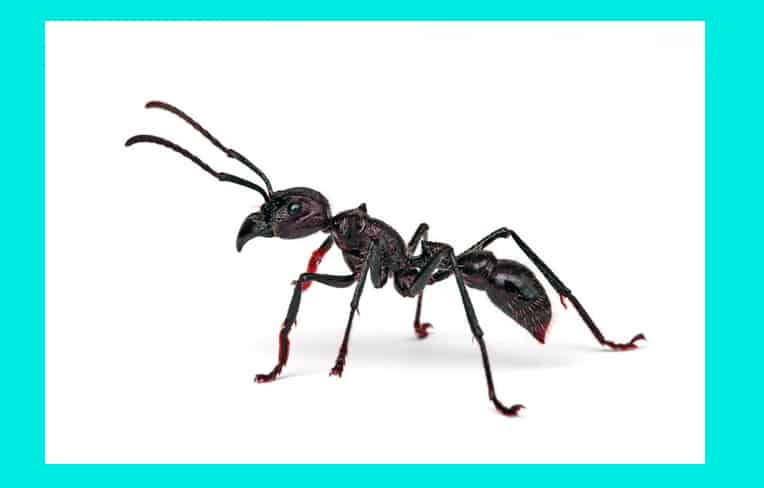Ant Keeping is one of the top new hobbies, and knowing which ants to start with is always a common question for beginners. Picking the wrong starter species can make starting this hobby incredibly hard.
The best ants to keep for beginners are found locally around your home because the ants you will see will be adjusted to that area’s climate, food, and water quality. Also, if you ever need to release the ants, they will be able to thrive in the local environment.
What Are The Best Ants for Beginners?
If catching ants to start your ant farm is not an option, the Messor Barbarus (harvester ant) is our choice for the best beginner ants.
There are some runner-ups, and these would also be excellent choices for beginners.
They include Black Garden Ants, Camponotus ants, and Carpenter Ants (Wood Ants).
While these have advantages, we believe having your own ant colony of Messor Barbarus is perfect for getting started.

This ant grows very quickly, has tiny worker ants, and feeds on seeds and dead insects that beginners will have an easy time finding.
The Messor Barbarus (Harvester Ant) is a fascinating species, especially when you consider that it mostly eats seeds.
More information about the Messor Barbarus and different keeping strategies are below.
Why We Suggest Beginner Ants
The hardest part for beginners is picking the best species to keep.
This is a tricky question for those without prior knowledge of ant keeping or starting an ant farm.
Globally, there are so many species of ants that it gets a bit overwhelming.
For beginners, keeping an easy and manageable species is always advisable.
Remember, these recommendations are based on the assumption that you couldn’t find ants locally around your local environment.
One of the most recommended ant species for purchasing is the Messor Barbarus, the harvester ant.
The name is derived from the seed-collecting nature of the ants, as it is their primary food source.
When keeping the Harvester ant, seeds (grass seeds) must be constantly supplied.
To keep the Messor Barbarus well hydrated, the colony needs to be decently moist, as they will get a lot of moisture from the seeds.
The moisture needs to be constantly monitored.
[amazon box=”B08QM81BJV”]Please do not overdo it; too much humidity can dampen the seeds and ruin them.
Also, if there isn’t a dry zone readily available in the formicarium, the ants will not have anywhere to bury their seeds!
The worker ant requires lots of energy. Make sure a constant supply of seeds is available.
Some ant keepers provide light sugar water or honey, but the syrup must be diluted to avoid the ants getting stuck.
Also, ants are prone to drowning in water; when supplying water, ensure it is in a cotton ball or sprayed onto the walls.
Make sure you are always giving your ants a way out!
The Messor Barbarus For Beginners
The Messor Barbarus ant has gained popularity as one the easiest ant to keep.
This makes it one of the most sort after ant species.
Some of the features that make it ideal for a beginner are;
Messor Barbarus Keeping Difficulty
The Messor Barbarus are easy to keep, and they survive on tiny grass seeds, which are easy to find and give.
They hydrate quickly, making water supply another easy part of keeping this ant.
To avoid the Harvester Ants losing all their moisture, store them in a relatively cool place.
They grow into massive colonies while only needing one Queen (Monogyne).
The Messor Barbarus Queen
In a colony, a Messor Barbarus ant has a queen ant that’s only role is to lay eggs to produce workers.
The Queen ranges from about 14mm to 18mm, and the moderate queen size and small worker size make it an ideal pick for your first ant farm.
Other queen ants can grow up to 52mm (Wow!), making keeping these other queens in homemade colonies challenging.
This makes Messor Barbarus the most suitable for beginners.
The Messor Barbarus Worker Ants
When starting on ant keeping, size is always a limitation.
The Messor Barbarus ant colony comprises tons of workers responsible for gathering food for the colony.
They grow to about 3mm, making them ideal for small homemade colonies.

Other worker ants can grow upwards of 6-12mm!
This would mean you would have to at least double your size if you chose a different type of ant.
Food For Messor Barbarus
(Most) Ants are omnivorous feeders.
They are feed on everything from dead insects to different types of seeds.
As a beginner, getting a variety of feeding materials can be challenging.
Keeping track of what food has been given and at what time is hard.
Raising an ant that feeds from a single easy-to-find source will save you a ton of time and effort.
The Messor Barbarus ant eats seeds that are easy to get, which makes keeping them more manageable.
Temperature and Humidity preference of Messor Barbarus
When keeping ants, the temperatures should always be below 90°F and should never be less than 60°F.
Outside of these ranges may cause the death of your ants.
The Messor Barbarus ant survives best at room temperature of up to 75°F.
These ants can even be kept in a cooler during the hot season.
Humidity is the level of water vapor available in the soil/sand/air around the ants.
The Messor Barbarus ant survives best in humidity levels of about 60%.
Despite not being a hot climate ant, the Messor Barbarus ant needs high humidity levels. This is due to its high hydration levels.
While performing your regular watering, double-check the food and energy of your ants.
(Spray the side of your formicarium)
[amazon box=”B08QM81BJV”]
Best Set-Up for A Messor Barbarus Habitat
As discussed earlier, the Messor Barbarus worker ants have smaller sizes than other ant species, so you can have a big colony while maintaining a smaller formicarium.
The formicarium is usually tiny for beginners, which is okay during the learning process.
The bigger the ant, the bigger the formicarium.
While you’re just getting started, the last thing you want is a massive ant farm.
Messor Barbarus Hibernation
Hibernation is the process where the ant goes into a state of dormancy, and this usually happens during the winter seasons.
The Messor Barbarus ant hibernates depending on the weather and temperature.
Most ant species hibernate during cold seasons.
If your temperature drops below 15 Celsius, your Harvester Ants will begin to enter a stage of hibernation.
A constant food supply and balanced temperatures can cause the ants not to hibernate.
Forced hibernation does happen, which allows the ants to rest and regain strength.
Putting the ants in a cooler place (some people use the garage) can trigger the ants to hibernate.
Be careful with this; sometimes, too drastic changes are bad for the ants.
Colony Size of Harvester Ant
Some other species of ants grow so fast that they will outpace their formicarium.
The Messor Barbarus ant adjusts the colony size depending on the formicarium.
A single colony can have up to 10,000 workers!
This makes it ideal for beginners, as you will probably have a smaller formicarium.
Substrate preference of Harvester Ant
A substrate is a base where the ant will live in.
For effective keeping of the Messor Barbarus, you should try to imitate its natural habitat.
The Messor Barbarus ant adapts to new habitations, unlike most ant species.
This makes it ideal for beginner ant keepers building their first ant farm (if you get the initial part wrong).
Just please do not do gel, as this is a terrible choice for any ant-keeping experience.
Basics of a Harvester Ant Farm
Ants are social insects and live in communities where workers share all the work.
The Queen’s primary task is laying eggs and growing the colony.
The workers are involved in the other aspects of the community like building, feeding the Queen, and gathering food.
The living structure of ants is known as a colony.
In a colony, every ant has its assigned social responsibility that they perform every day.
Types of Ant Farms for Harvester Ants
While the Classic Ant Farm takes a little more investment to set up, we believe as a long-term solution for it to be the best!
Classic Ant farm
Made of two pieces of glass covering the length and two blocks of wood covering the width.
A covering lid with holes and a stand.
Glass Jars Set-up
Made of two glass jars; a smaller one and a larger one.
The smaller one goes into, the larger one. Poke some holes in the lid to let some air in.
Ytong Ant Nest
Lightweight concrete that is easy to mold and allows regular moistening.
Usually, these will come with compartments and tunnels already made, and you just need to cover them with a glass lid.
Best for viewing!
The above are some simple ways to create an ant farm home. There are many more, and I suggest you try them all.
Like any other pet, food is always an essential part. Ants need nutrition and constant care.
The area around the nest must be clean and free from any form of parasite or toxins that would endanger the ants. Ants for survival require proper nutrition.
How To Feed Your Harvester Ants On Your Ant Farm
Proteins
Protein is essential to a colony’s diet and is used to feed the larvae to help them grow and foster.
The Queen also needs the protein to be adequate and lay eggs.
The main component of their diet is actually seeds, and they will get a ton of their nutrients from them.
However, don’t be afraid to throw some meat in there every so often.
Who doesn’t like a little treat every now and then?
Carbohydrates
Worker ants work hard.
The workers are not growing anymore and tend to use more carbohydrates to supply them with energy while performing.
Think about how you use carbs to work out.
Sugar or honey syrup is given to the ants to provide them with much-needed energy.
(Potential cheat code!)
Water
Ants may appear small in size, but they must also stay hydrated.
Water can be supplied by spraying the walls of the colonies moist or using a tube with a cotton ball at the end that traps the water.
Ants to avoid
We know some guides out there will suggest many different ants.
Be careful with this, as we do not suggest the bulldog ant, fire ants, and many other ants and ant colonies for first-time ant keepers.
While raising a black garden ant colony is a runner-up – these ants listed above are not.
The point of your first ant farm is to ensure that your own colony prospers.
After you’ve gained experience with something like the black garden ant or the harvester ant, move on to something exotic like the fire ant or bulldog ant.
Here’s a picture of the bulldog ant, you probably will never find these, but they look pretty cool.
They’re also huge!

Final Thoughts on Keeping Harvester Ants
Keeping a Messor Barbarus colony will be an incredible learning journey for new ant keepers.
It creates room for errors, allowing newcomers to grow the needed skills to keep other types of ants.
The significant risk associated with the Messor Barbarus ant is its powerful bite.
Be careful, but also – Have fun!
Already found a queen ant and are ready to start your ant farm?
Check out this guide for what to do next: Beginner Friendly Ant Keeping Guide.
Happy Keeping.






